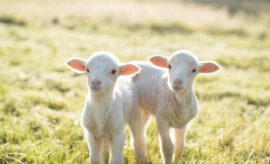With spring only 4 weeks away, we thought it timely to highlight how pregnancy scanning can assist you to make the most of this crucial period in the farming calendar. Ultrasonography is a powerful tool allowing you to optimize your flock’s nutrition and ultimately improve lamb survival rates. And, it is much more accessible than you may first think.
It offers numerous advantages that go beyond merely identifying wet and dry ewes. This technology empowers us to gain critical insights into our ewes' reproductive status, allowing us to:
- Identify Multiple-Bearing Ewes[1]: By determining the number of lambs each ewe is carrying - singles, twins, or triplets; we can make informed decisions about paddock allocation. Allocating multiple-bearing ewes to the best paddocks with abundant feed and shelter ensures their optimal nutrition and increases their chances of successful lambing. This is particularly useful when feed is at a premium.
- Use Paddock allocation for Improved Lamb Survival[2]: During gestation, it's vital to provide our ewes with the best possible nutrition. Well-nourished ewes are more likely to produce healthier lambs with higher birth weights, leading to better survival rates. Pregnancy scanning helps us allocate paddocks strategically, managing feed resources effectively and supporting successful lambing outcomes.
Planning Feed Requirements
To ensure that our pregnant ewes receive the nutrition they need, we must carefully plan their feed requirements. Here are some essential guidelines provided by AWI for paddock feed management during lambing season[3]:
- Mixed Perennial Pastures: Aim for a feed on offer of at least 1,200 kg green DM (Dry Matter)/ha in lambing paddocks. For twin and triplet lambing ewes, strive for even higher feed quantities to meet their increased nutritional needs.
- Annual Clover-Based Pastures: At the beginning of lambing, target a feed on offer of 1,500 kg - 1,800 kg green DM (Dry Matter)/ha. This will provide the necessary nutrition for a successful start to the lambing season.
Culling Decisions for Improved Efficiency
Pregnancy scanning offers another essential benefit: the ability to make informed culling decisions. With discussions of a below median rainfall for August to October across much of Australia; making informed culling decisions is even more important. Being able to identify dry ewes and potentially single-bearing ewes provides knowledge about which animals are consuming valuable resources without contributing significantly to lamb production. Culling them first will assist to optimize the flock's overall reproductive efficiency.
If you are interested in learning how to do your own ultrasound pregnancy scanning, check out our website for upcoming training opportunities.
Bralca.com: creating choice through knowledge
By: Beth Simmons
[1] https://www.agric.wa.gov.au/management-reproduction/managing-pregnancy-ewes?page=0%2C4#smartpaging_toc_p4_s1_h3
[2] https://www.mla.com.au/research-and-development/Genetics-and-breeding/sheep/reproduction/ewes/



